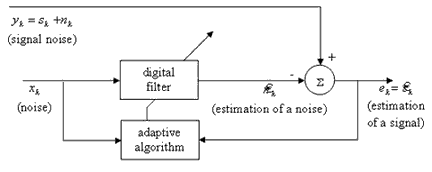|
The adaptive filter is a digital filter with self-adjusted characteristics. Such filter automatically adapts for changes of target signals. The adaptive filter has distinctive feature: its frequency characteristic is automatically regulated or modified for improvement of productivity of the filter according to some criterion. It allows the filter to adapt for changes of characteristics of an entrance signal.
The adaptive filter consists of two various parts: the digital filter with adjustable coefficients and adaptive algorithm which is used for adjustment or change the coefficients of the filter (fig. 1).

Figure 1 – The structure of the adaptive filter-squelcher
On the adaptive filter two entrance signals
 and and
 . The signal . The signal
 is polluted and contains a useful signal is polluted and contains a useful signal
 and noise and noise
 .It is supposed that these signals do not correlate. The signal .It is supposed that these signals do not correlate. The signal
 is a measure of the polluted signal which correlates with is a measure of the polluted signal which correlates with
 . In the digital filter the signal . In the digital filter the signal
 is processed for reception of an estimation is processed for reception of an estimation
 of a signal of a signal
 . Then the useful signal is estimated as a difference noisy signal . Then the useful signal is estimated as a difference noisy signal
 and an output of the digital filter and an output of the digital filter
 : :
 . .
The basic purpose of squelcher consists in reception of an optimum estimation of noise in noisy signals, and consequently, an optimum estimation of a desirable signal. For this purpose
 moves in a circuit (path) of a feedback, and on the basis of this signal and suitable adaptive algorithm the coefficients of the digital filter for minimization of noise in a signal
moves in a circuit (path) of a feedback, and on the basis of this signal and suitable adaptive algorithm the coefficients of the digital filter for minimization of noise in a signal
 are adjusted.
are adjusted.
For adjustment{option} of coefficients of the digital filter (fig.2) adaptive algorithms are use. In adaptive algorithms the signal of a mistake{an error}
 is minimized according to some criterion, for example, under the schemeof the least squares. The greatest distribution was received the algorithms in which are used the scheme of the least squares (LMS) and the recursive scheme of the least squares (RLS).
is minimized according to some criterion, for example, under the schemeof the least squares. The greatest distribution was received the algorithms in which are used the scheme of the least squares (LMS) and the recursive scheme of the least squares (RLS).

Figure 2 - The functional scheme of an adaptive filtration under the scheme the least squares
|





